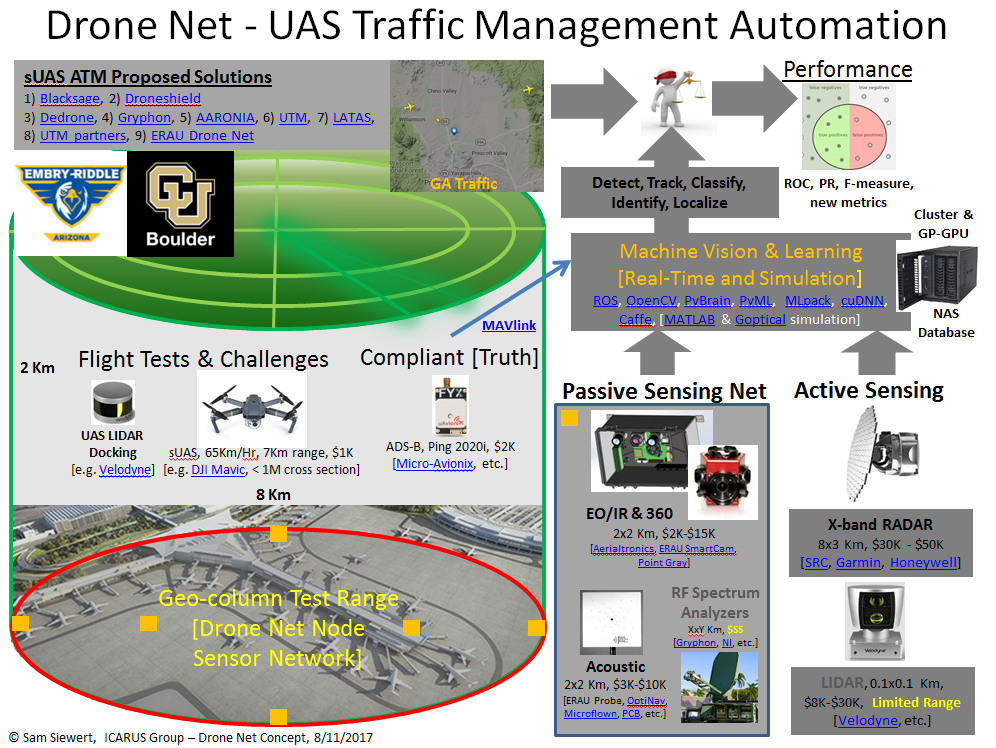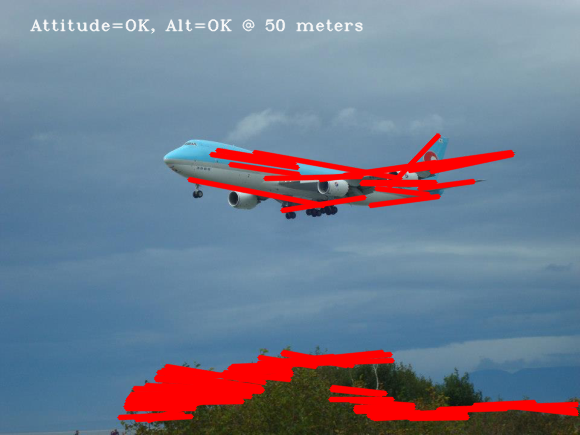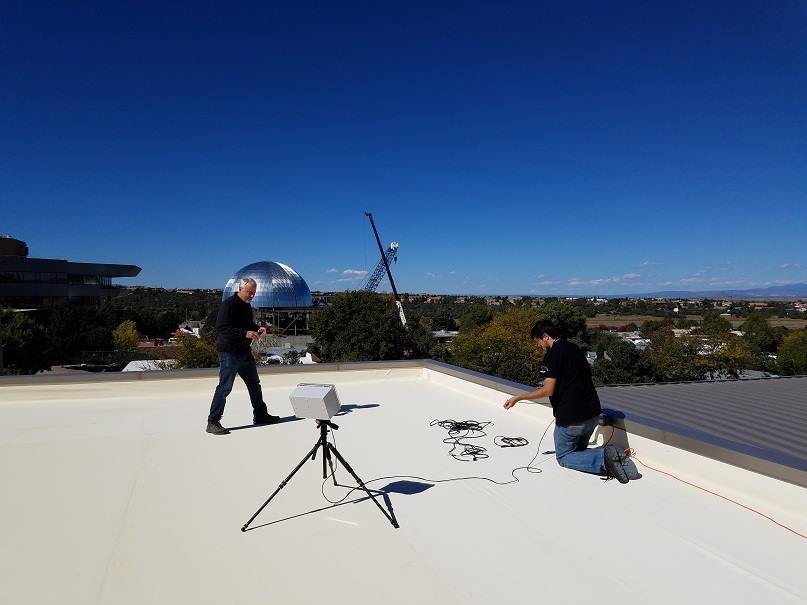131-140 of 189 results
-
UAV-based tools in forest environments
PI Scott Post
Measuring turbulent wind forces in forests to understand the forces on UAVs in flight, with a goal of being able to keep a UAV in position to mm tolerance.
Categories: Faculty-Staff
-
Astronomy
PI Pragati Pradhan
CO-I Brian Rachford
CO-I Noel Richardson
Astronomy is one of the oldest sciences, as people have been observing and learning from the stars for thousands of years. Astronomy has expanded beyond visible light to include the full spectrum of electromagnetic waves, from radio to x-rays and gamma rays, as well as cosmic messengers beyond the electromagnetic spectrum.
Embry-Riddle Prescott's astronomy research covers a broad range of topics and observation techniques, with a particular focus on binary star systems. Our Campus Observatory includes 20-inch and 16-inch optical telescopes, several radio dishes and cameras for meteor observations. Student and faculty researchers work with data from both space-based satellites spanning the electromagnetic spectrum from the high-energy X-rays through the thermal infrared, as well as ground-based optical and infrared telescopes across the globe. Our astronomy faculty has a strong track record of publications with student authors and receives external funding from various sources, including NASA and the Space Telescope Science Institute.Categories: Faculty-Staff
-
Investigate Detect and Avoid Track Classification and Filtering
PI Richard Prazenica
CO-I Troy Henderson
CO-I Morad Nazari
CO-I Tyler Spence
This research will identify key sources of uncertainty in representative detect and avoid architectures and assess the downstream risks and effects of spurious information on downstream system performance
In this project, which is funded by the FAA ASSURE program, the research team consisting of The Ohio State University, Embry‑Riddle Aeronautical University, Mississippi State University, University of North Dakota and Cal Analytics will work together to:
- Identify the key sources of misleading surveillance information produced by airborne and ground-based detect and avoid (DAA) systems. Develop risk modeling and analysis tools to assess the system-wide effects of false or misleading information on alerting and separation, as well as impacts on pilots in command (PIC) and air traffic operators.
- Provide guidance and recommendations for track classification and filter performance and safety requirements to standards bodies, including Radio Technical Commission for Aeronautics (RTCA) and American Society for Testing and Materials (ASTM) DAA working groups, and inform Federal Aviation Administration (FAA) rulemaking on DAA operations.
Current guidance provided by the Federal Aviation Administration has made beyond visual line of sight (BVLOS) missions an executive priority. Key to the success of these missions is the development of DAA systems capable of providing accurate pilot in the loop, or autonomous deconfliction guidance. Current standards for DAA services provided by RTCA and ASTM do not address the requirements for system performance with respect to generation of false or misleading information to the PIC or autonomous response services of the unmanned aircraft system. This research will identify key sources of uncertainty in representative DAA architectures and assess the downstream risks and effects of spurious information on downstream system performance. Additionally, recommendations will be developed for track classification accuracy requirements that provide sufficient safety margins for enabling DAA services in support of BVLOS missions.
Categories: Faculty-Staff
-
Argumentative Knowledge Construction in Asynchronous Calculus Discussion Boards
PI Zackery Reed
CO-I Darryl Chamberlain
CO-I Karen Keene
Social learning tasks can provide additional cognitive benefits to students. These tasks are necessarily different in an asynchronous environment though. Our proposed study will investigate how instructors can encourage students to socially construct knowledge during asynchronous discussions.
Categories: Faculty-Staff
-
Researching How You Teach Holistic Modeling (RHYTHM)
PI Kelsey Rodgers
CO-I Matthew Verleger
CO-I Lisa Davids
"Models are a critical part of the analysis and design of engineered systems. The purpose of multiple types of models (physical, mathematical, computational, and financial) is to provide a simplified representation of reality that mimics the features of the engineered system, and that predicts the behavior of the system. This project, a collaboration between Embry-Riddle Aeronautical University, San Jose State University, and the University of Louisville, aims to improve engineering students' modeling competence. The project plans to achieve this goal by transforming first-year engineering courses to teach modeling as an engineering tool. The project will change existing course materials, pedagogy, and assessment methods across the three institutions. Each institution will implement its own specific strategy to teach mathematical, physical, computational, and financial modeling, thus providing three different approaches. By comparing student's modeling abilities across the institutions and approaches, the project aims to identify the most impactful approaches for teaching multiple modeling in introductory undergraduate engineering courses.
The project is guided by a "holistic modeling perspective" theoretical framework, that builds on the successful "Models and Modeling Perspective" and "Computational Adaptive Expertise" frameworks. The objectives of the project are to: (1) implement, test, and refine holistic modeling environments for institutions that have flexibility in changing curriculum and for instructors that have different degrees of interest in changing their course(s); (2) implement, test, and refine methods to assess students' modeling abilities; and (3) evaluate and present the results of modeling abilities attained by students at three different universities. A unified language and discussion around modeling will be adopted in all revised courses. An assessment tool to measure students' modeling competence will be developed and implemented at each university. This work builds upon existing research in the development of more easily adaptable and adoptable modeling pedagogies and modeling languages. The following broad research question guides the research: How do students' definitional knowledge, ability to apply, and ability to create models change based on different degrees of modeling integration in the classroom?
This award reflects NSF's statutory mission and has been deemed worthy of support through evaluation using the Foundation's intellectual merit and broader impacts review criteria."
Categories: Faculty-Staff
-
EXTENDING THE LAUNDERED FUNDS DESTINATION THEORY: APPLYING THE WALKER-UNGER GRAVITY MODEL TO RUSSIAN-BASED MONEY LAUNDERER COUNTRY PREFERENCE FROM 2000-2020
PI Juan Roman
CO-I Thomas Schaefer
CO-I Ana Machuca
Determine Russian-based money launderer destination preferrence.
The quantification of illicit finance practices along with the generated revenue from transnational criminal activity and their presence within the global financial system is still a new phenomenon. Careful examination of the effects of money laundering is needed in order to develop strategies to combat the problem. The literature suggests attempts to quantify the presence of laundered funds in the global economy are inaccurate. This research applied the modified Walker-Unger model to show the degree of attractiveness of a country for Russian-based money launderers to send their illicit funds for the 2000-2020 time period. The theoretical justification for this investigation is that once the scale of unlawful financial flows are known, the likely impact on society can be analyzed.Categories: Faculty-Staff
-
A Knowledge-based Consultant for Diagnosing Toxic Exposures
PI Joel Schipper
Joel Schipper of Electrical and Computer Engineering works with the Florida Poison Information Center to develop a knowledge-based system to aid in the timely diagnosis of exposures to unknown toxins.
Categories: Faculty-Staff Undergraduate
-
Transfer and Retention of Training in Real and Virtual Spaceflight Environments
PI Erik Seedhouse
This research compared how effectively suborbital tasks are learned in an actual NBE compared with a VR-rendered NBE. This study demonstrated the efficacy of NBE-type training as a means to improve the effectiveness of training suborbital SFPs.
Manned suborbital spaceflights are just around the corner. SpaceShipTwo, operated by Virgin Galactic and New Shepard, operated by Blue Origin, will most likely fly fare-paying passengers sometime in 2020. Each passenger will pay $250,000. And, with just four minutes (240 seconds) of actual microgravity time, that equates to almost $1000/second. For spaceflight participants (SFPs) a category which will include tourists and scientists, the cost of incorrectly performing even simple tasks will be extremely costly.
In spaceflight, even for highly trained astronauts, the tactile-kinesthetic and vestibular systems are affected by weightlessness. Of course, astronauts traveling to the International Space Station (ISS) have plenty of time to adapt, but SFPs will have no time at all – the time from rocket ignition to microgravity is less than 5 minutes. Compounding this lack of adaptation is the fact that suborbital SFPs will generally only have 3 days of training (compared with many years of training for an astronaut headed to the ISS). To overcome the aforementioned difficulties this study evaluated two spaceflight analogous training systems specific to suborbital spaceflight: one that will take place in an actual neutral buoyancy environment (NBE) and one that will take place in a virtual reality (VR) NBE.
To date, there have no studies that have evaluated the effectiveness of VR as a means of training suborbital SFPs. Nor have there been any studies that evaluate the utility of NBE-type training for suborbital SFPs. Not only did this study assess the effectiveness of each of these methods of training. It also developed a training tool for the commercial suborbital spaceflight industry. To that end, this study sought to achieve three objectives:
- Measure the effectiveness of neutral buoyancy dive training while wearing the EasyDive system as a means to train suborbital SFPs in a swimming pool
- Measure the effectiveness of neutral buoyancy dive training in an underwater-simulated VR environment as a means of improving maneuvering and performance of tasks in microgravity.
- Based on the results of objectives #1 and #2 a training program for SFPs will be devised.
Categories: Faculty-Staff
-
An Empirical Study of the Evolution of Homeland Security Definitions in Federal Documents
PI Alexander Siedschlag
CO-I Andrea Jerkovic
This ongoing empirical study (quantitative systematic review) systematically tracks the evolution of official homeland security definitions from related federal strategies, frameworks, guidelines, the Quadrennial Homeland Security Reviews (QHSRs), enterprise agencies’ strategic plans, and pertinent legislation. Continuing and changing ingredients of the sprouting public policy and strategy definition of homeland security will be identified.
Twenty years after 9/11, the field of homeland security has benefited from several conceptual studies. Those assessed and made recommendations on main domains of homeland security from scholastic and normative viewpoints, how the concept of homeland security should be mirrored in curriculum development, evolution, and program learning outcomes, and what competencies a homeland security graduate, scholar, and educated practitioner needs. However, few studies and texbooks address the evolution of the term of homeland security in the homeland security era from 9/11 to now. While valuable analyses of how homeland security predates and transcends 9/11 have increased, systematic study of how the concept and meaning of homeland security have evolved over the past 20 years continues to be scarce. This ongiong empirical study (quantitative systematic review) systematically tracks the evolution of official homeland security definitions from related federal strategies, frameworks, guidelines, the Quadrennial Homeland Security Reviews (QHSRs), enterprise agencies’ strategic plans, and pertinent legislation. Continuing and changing ingredients of the sprouting public policy and strategy definition of homeland security will be identified.Categories: Faculty-Staff
-
ICARUS Drone Net
PI Samuel Siewert
CO-I Iacopo Gentilini
CO-I Mehran Andalibi
CO-I Stephen Bruder

Drone Net is a conceptual architecture to integrate passive sensor nodes in a local sensor network along with traditional active sensing methods for small Unmanned Aerial Systems traffic management. The goal of the proposed research architecture is to evaluate use of multiple passive sensor nodes integrating Electro-Optical/Infrared and acoustic arrays networked around a UAS Traffic Management operating region (Class G uncontrolled airspace). The Drone Net approach will be compared to and/or used in addition to RADAR and Automatic Dependent Surveillance-Broadcast tracking and identification. We hypothesize that this approach can better manage non-compliant small UAS along with compliant UAS and general aviation in sensitive airspace, urban locations, and geo-fenced regions.
Drone-Net: Information Fusion Networks for Reliable Localization
ICARUS Research Group: ERAU Prescott
The challenge and opportunity presented by use of UAS “drones” in the national airspace (NAS) has historic significance not seen since the early days of aviation growth after the First World War. The FAA estimates that by 2020 the drone market will be $98 billion with 7 million drones added annually [1]. Market beneficiaries include industrial inspection, aerial photography, insurance, agricultural and government services [1]. While ADS-B for drones, along with registration, has been proposed as a quick fix, to allow drones into the NAS and to share populated areas, it is not clear how this will work for all types of drones ranging from professional service to hobby. For example, many drones will be fully compliant, but some may be semi-compliant (e.g., low quality position reporting due to degraded GPS), and others perhaps even totally non-compliant or hostile [2].

Embryonic research at ERAU Prescott to develop a drone detector, which can be placed on roof-tops and networked with other detectors and information services, has shown that multi-spectral EO/IR detection is quite effective. The feasibility of passive methods for civil aviation detection of aircraft not using ADS-B and not registered on flilghtradar24 [3] (via primary and secondary RADAR) has been experimentally observed.

The ICARUS group at ERAU Prescott is working to fly and test ADS-B on drones [9] that are compliant, semi-compliant, and non-compliant in order to evaluate methods of detection, classification and identification. Research by Sandia National Labs has shown that drones typically have very low RADAR cross-section area, similar to stealth aircraft [4] and can present a significant security and safety threat. The risk is that even one or two national security incidents involving service drones, hobby, or terrorism could result in the grounding of all drones in the NAS.

Multiple studies [4, 5] have substantiated the conclusion that no single sensing modality will suffice to reliably detect and localize a wide variety of drones. To this end, the ICARUS group proposes to pursue a heterogeneous information fusion approach with passive EO/IR and progressing to a “richer” passive/active sensor suite. Prior ICARUS research partially funded by DHS ADAC Center of Excellence (CoE) led to development of the SMDSI (Software Defined Multi-Spectral Imager) to detect and track marine traffic [6, 7]. This existing hardware will be adapted to accommodate additional sensors including acoustic, ADS-B, primary/secondary RADAR, and LIDAR in order to accelerate the development of optimal methods of drone detection, classification, and identification.

The first year of this proposed effort, will involve basic research in machine learning, machine vision, real-time systems, and the development of suitable information fusion algorithms, continuing through the duration. The test configuration will be documented to facilitate replication at other participating academic research organizations (ERAU Daytona ASSURE [11], U. of Alaska ACUASI [12], U. of Alaska DHS ADAC, and U. of Colorado Boulder Embedded Systems Engineering) in year two of the proposed research. Each collaborator can provide unique synergy to enhance research objectives and are potential future external funding partners. The team will include ERAU Prescott faculty, undergraduate students, CU Boulder graduate ESE students, and collaboration with faculty at U. of Alaska and Colorado. In the third year of work, passive capabilities can be enhanced with active LIDAR and existing RADAR at ERAU Prescott. The goal is to develop unique sensor fusion algorithms as well as machine learning and traditional salient object detection and classification methods.
The images collected over the lifetime of the project can further be saved in a distributed database of observed compliant, compliant-low-quality, non-compliant and perhaps hostile drones and shared between “Drone net” nodes. The overall vision is to create a network of passive/active drone detection, classification, and identification nodes to enhance security and safety for drone operations that surpasses ADS-B and registration alone [10]. The capability can be used to test and evaluate commercial drone detection systems being evaluated by the FBI at airports [8] and to make policy and technology recommendations to key agencies (FAA, DOT, DHS) for drone integration into the national air space. Drone net will enable ICARUS to pursue external funding from DHS CoEs, ONR (Office of Naval Research), NASA AIST (Advanced Information Systems Technology), FAA ASSURE, SBIR/STTR, and industry.
References
[1] FAA Aerospace Forecast, Fiscal Years 2016-2036, Federal Aviation Administration.
[2] How consumer drones wind up in the hands of ISIS fighters, Techcrunch, October 13, 2016.
[3] flightradar24.com, ADS-B, primary/secondary RADAR flight localization and aggregation services.
[4] Birch, Gabriel Carisle, John Clark Griffin, and Matthew Kelly Erdman. UAS Detection Classification and Neutralization: Market Survey 2015. No. SAND2015-6365. Sandia National Laboratories (SNL-NM), Albuquerque, NM, 2015.
[5] McNeal, Gregory S. "Unmanned Aerial System Threats: Exploring Security Implications and Mitigation Technologies." Available at SSRN (2015).
[6] Arctic Domain Awareness Research Center, U. of Alaska Anchorage, Theme 3, Task 2, SmartCam.
[7] S. Siewert, M. Vis, R. Claus, R. Krishnamurthy, S. B. Singh, A. K. Singh, S. Gunasekaran, “Image and Information Fusion Experiments with a Software-Defined Multi-Spectral Imaging System for Aviation and Marine Sensor Networks”, (in preparation) AIAA SciTech, Grapevine, Texas, January 2017.
[8] FAA Tests FBI Drone Detection System at JFK, Federal Aviation Administration, July, 2016.
[9] Micro-Avionix, Ping2020 ADS-B transponder for UAS.
[10] Rhode & Schwarz, Protecting the Sky - Signal Monitoring of Radio Controlled Civilian Unmanned Aerial Vehicles and Possible Countermeasures, October 2015.
[11] ACUASI, Alaska Center for Unmanned Aircraft Systems Integration, http://acuasi.alaska.edu/, Dr. Mike Hatfield.
[12] ASSURE, Alliance of System Safety for UAS through Research Excellence, http://assureuas.erau.edu/, Dr. Richard Stansbury.
Categories: Faculty-Staff
131-140 of 189 results
